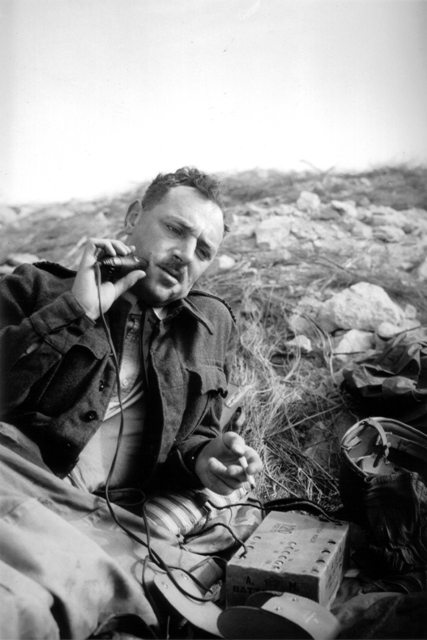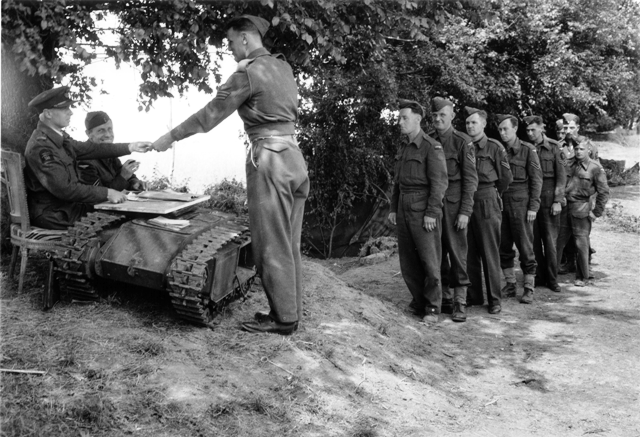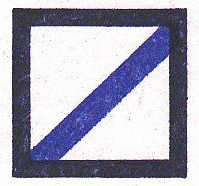This unit began life as No. 4 R.A.F. Beach Unit in January 1944 and was renamed as No. 4 R.A.F. Beach Squadron in April 1944. Although it was the last of the four beach units to be created for the invasion of Normandy it was formed from the most experienced personnel. For many of them Operation “OVERLORD” was to be their third D-Day.
No. 4 R.A.F. Beach Unit
Nos. 68 and 69 R.A.F. Beach Units returned from the Mediterranean Allied Air Force at the end of 1943. As a result of the disbandment of the North African and Middle East beach units to form a single Mediterranean beach unit they brought with them some personnel who had been with Nos. 31, 32, 33 and 35 Middle East Beach Bricks and Nos. 81 and 82 Auxiliary Embarkation Units.
The planners at Allied Expeditionary Air Force Headquarters decided they needed a fourth beach unit for Operation “OVERLORD” and, having heard of the return of two beach units to the U.K. requested that they be formed into a new unit to the same establishment as Nos. 1, 2 and 3 Beach Units. This was approved by the Air Ministry and, accordingly No. 4 R.A.F. Beach Unit, consisting of a Headquarters and Nos. 107 and 108 Beach Sections was formed at R.A.F. West Kirby. This was completed in January 1944 and the Unit was transferred from Technical Training Command to 2nd Tactical Air Force with effect from 1st February 1944.
The Commanding Officer was Wing Commander J.E.T. Murphy (31287), who, as a Squadron Leader had been the C.O. of No. 35 Beach Brick, R.A.F. Component. The commander of 107 Beach Section was Squadron Leader H.M. Butler (72182) and the 108 Beach Section commander was Squadron Leader C.W. Lovatt (31230), who had previously been the Commanding Officer of No. 33 Beach Brick, R.A.F. Component.
Instructions had been issued by H.Q. 2nd T.A.F. about a training programme for Nos 1, 2, 3 and 4 R.A.F. Beach Units that was to commence on 1st February. From 1st February until 31st March, the M.T. sub sections of No. 4 R.A.F. Beach Unit (2 officers and 33 other ranks) along with those of No. 3 R.A.F. Beach Unit were attached to 71 Mechanical Transport Light Repair Unit at Hamptons House near West Malling for training. From 6th February until 31st March, the Petrol and Ammunition sub sections (4 officers and 10 other ranks), along with those of Nos. 1 and 2 R.A.F. Beach Units were attached to 407 Air Ammunition Park at Burrswood for training. From 7th February until 4th March, 5 other ranks from the Landing sub sections, along with landing personnel from No. 3 R.A.F. Beach Unit, were attached to No. 8 Embarkation Unit, Glasgow for training.
No. 4 Beach Unit H.Q. moved from R.A.F. West Kirby and was located at H.Q. 2nd T.A.F. at Bracknell in Berkshire with effect from 12th February.
The Equipment sub sections of all four Beach Units were instructed to go to B.M.U. at R.A.F. Station Stapleford Tawney for training in the period 7th to 28th February and the Landing sub sections of all four Units were to be at the B.M.U. from 6th to 31st March. However the Operations Record Book of 4 Beach Unit only refers to 1 airman being attached to B.M.U. for training on 11th February. The Provost sub sections of all four Beach Units were also instructed to go to “The Roughets”, White Hill, Bletchingly, Surrey for training from 14th to 28th March but there is no mention of that in 4 Beach Unit O.R.B. either. This might be explained by the fact that on 20th March, No. 3 R.A.F. Beach Unit was placed in reserve, and No. 4 Beach Unit took the place of that unit operating with 104 Beach Sub Area and its two Beach Groups. No. 4 Beach Unit therefore promptly moved to Hampshire where 104 Beach Sub Area was now located.
On the 28th March it was reported that all personnel of 107 Beach Section were attached to No. 9 Army Beach Group at Hursley, all personnel of 108 Beach Section were attached to No. 10 Army Beach Group at Beaulieu and the Headquarters staff were attached to 104 Beach Sub Area at Southampton. Also on 28th March Flight Lieutenant Leslie Arthur Taylor was posted to No 4 Beach Unit from No. 3 R.A.F. Beach Unit. Taylor was promoted to Acting Squadron Leader and given command of 107 Beach Section (later Beach Flight) in place of S/Ldr. Butler, but the details of this are not recorded in the Unit O.R.B.
On 9th April, leaving behind small administrative parties, 107 and 108 Beach Sections went to Bracklesham to take part in Exercise “CROPPER”. The exercise continued until 13th April. All personnel were fed in ‘dryshod’ and no stores were landed.
On the 17th and 18th April, the Landing and Provost sub sections of both Beach Sections participated in Exercise “SMASH III”. No vehicles or stores were landed.
No. 4 R.A.F. Beach Squadron
On 17th April 1944, the 2nd Tactical Air Force beach units were officially renamed, so that No. 4 R.A.F. Beach Unit became No. 4 R.A.F. Beach Squadron and its Beach Sections (Nos. 107 and 108) became Beach Flights. This was a change of name only and made no practical difference to the unit.
At the end of April came Exercise “FABIUS II”. This was a full scale exercise at Hayling Island. The exercise began on 30th April and finished on the 4th or 5th May. The Squadron Operations Record Book reports “Owing to adverse weather conditions many personnel on L.S.T.s were unable to land and returned to Southampton. Personnel fed in ‘dryshod’ 2 days prior to landings, took the opportunity of making themselves fully aquainted with the local geography by gleaning all available information from local hostelries.”
Some personnel were given a week’s embarkation leave and when they came back it was time to move to final marshalling areas. The Squadron Headquarters moved on 13th May. One Jeep, one Bedford 3 ton lorry, and a total of 19 men left Southampton for Camp R7 near Ipswich. Two men remained in Southampton with the other H.Q. 3 ton lorry. They were going to sail separately to land two days after the rest. On the same day most of 107 Beach Flight left Hursley. The largest party went to Camp R7 at Ipswich. A smaller party went to Camp R8 (also at Ipswich) and a small party remained at Hursley. Similarly, most of 108 Beach Flight left Beaulieu. Again, most of them went to Camp R7 but a small party went to Camp T2A at Canning Town and another small party stayed in Beaulieu.
When, on the 19th May, two 107 Beach Flight men in a jeep and two 108 Beach Flight men in a jeep arrived at Camp C22 in Southampton (from Hursley and Beaulieu respectively), all the components of 4 Beach Squadron were in their appropriate marshalling areas to be phased in for landing on 1st, 2nd, 3rd and 4th tides.
While the Squadron personnel were moving into their marshalling areas, there were some late changes among the officers. F/Lt R M Ashton was posted in from No. 3 R.A.F. Beach Squadron on 14th May and signals officer, Flying Officer G. Taplin, was swapped with Flying Officer W.L. Smith from 3 R.A.F. Beach Squadron on 20th May.
From 2nd to 4th June embarkation was in progress for the assault on Normandy.
No. 4 Beach Squadron in Operation “OVERLORD”
No. 4 R.A.F. Beach Squadron was part of the Army’s 104 Beach Sub Area, operating in the GOLD Assault Area. 104 Beach Sub Area was the organisation responsible for setting-up and operating the ‘SUN’ Beach Maintenance Area. From D-Day to D+1, 104 Beach Sub Area was controlled by 50th Division, from D+1 to D+5 by H.Q. 30 Corps and from D+5 onwards by H.Q. 11 Lines of Communication Area.
On D-Day, the advanced parties of No. 107 Beach Flight and No. 108 Beach Flight landed early on KING and JIG beaches (1st Tide). (Follow the links to read about the individual Flights). No R.A.F. stores or personnel came ashore in the GOLD area on the first day.
The bulk of No. 4 Beach Squadron including the Headquarters, arrived 2nd Tide. Squadron Headquarters with Wing Commander Murphy and the Signals Section came ashore at H + 19½ hours (3 .00 a.m. on 7th June). Headquarters were set up in a house near Ver-sur-Mer. The author of the Squadron Operations Record Book wrote, “Accommodation was not satisfactory and provided little protection, but was the best available at that stage of the assault.”
At 10.00 on the morning of 7th June, the Signals Section under F/O W. L. Smith was operating from a large shell hole overlooking the KING beaches and W/T contact was made immediately.

On 8th June, coasters started working and L.S.T.s and L.C.T.s were beached. A joint Army and R.A.F. P.O.L. Dump was opened at a site between Meuvaines and Crépon and P.O.L. began to arrive over the beaches.
The Ammunition Section moved to the Army B.A.D. near Ryes on the 9th June. The R.A.F. Servicing Commandos at Refuelling and Re-arming Strip No. 1 reported that they had sufficient ammunition for operations1 and so the Squadron began building up stocks at the Dump. With some difficulty, Pioneer labour was obtained for the Dump.
Beach work “continued heavily” on 10th June and many vehicles and personnel were passed through. During an early morning enemy air raid, a bomb was dropped near the Drowned Vehicle Park. Lorries were damaged by splinters and F/Sgt Bown (who had been with No. 68 R.A.F. Beach Unit at Sicily and Salerno) was wounded. He was subsequently evacuated to the U.K. At 16.00 on 10th June, Sub Lt. L. Martin and P/O C. K. Davis, two pilots shot down over the area, were embarked for U.K. and at 21.45, four American pilots and one R.A.F. pilot who had been shot down over the area were embarked.
On 11th June, the Squadron was informed that the Army required the area used for the R.A.F. Ammunition Dump for expansion and a new dump in the vicinity of Ryes was set up. Stocks of ammunition were moved to the B2 Airfield at Bazenville.
On 12th June, instructions were received for pre-stocking B5 (Le Fresne Camilly) and B6 (Coulombs, St.Croix-Grand-Tonne) airfields and this work was commenced immediately. S/Ldr Lovatt, C.O. of No. 108 Beach Flight, visited the newly established H.Q. of No. 89 R.A.F. Embarkation Unit at Arromanches. Also that day, three personnel of 8th U.S.A.A.F. were embarked for the U.K. Two of these had force-landed on No. 1 R & R. Strip, and one had parachuted on to the beach.
F/Lt Roberts visited 89 Embarkation Unit on the 13th June, about the re-routeing of petrol from Port-en-Bessin to No. 104 Beach Sub-Area and, on the 15th June, the roads from Port-en-Bessin to 104 Beach Sub Area P.O.L. and Ammunition dumps were signposted by 89 Embarkation Unit. 83 Group asked for Provost to assist in routeing traffic.
At around 20.15 on the 15th June LAC Maxfield was killed by the explosion of a mine in the bivouac area of 107 Beach Flight. He was buried on 16th June at Ver sur Mer. The burial service was conducted by Padre Scott.
The next event to be noted was the great storm which is described in the Squadron Operations Record Book as follows:
| Date | Summary of Events |
|---|---|
| 19.6.44 to 21.6.44 | STRONG NORTHERLY WIND WITH HIGH SEAS AND ALL UNLOADING WAS CURTAILED. THIS WAS THE MOST SEVERE STORM FOR MANY YEARS ON THIS COAST AND MUCH DAMAGE WAS DONE TO LANDING CRAFT AND RHINOS. |
| 22.6.44 | Rough seas moderated and beaching of Craft continued at speed to offset delay of past few days. |
The R.A.F. Petrol Depot in the SUN Beach Maintenance Area ceased to function on 23rd June and all stocks were transferred to No. 407 A.F.A.P.
On 26th June F/Lt. Wilson of No. 107 Beach Flight was attached to Squadron Headquarters for “movement duties” in place of F/Lt. W.S. Smith (the Squadron Adjutant). The R.A.F. Ammunition Dump in the SUN Beach Maintenance Area ceased to function on this date, all stocks having been transferred to No. 407 A.F.A.P.
On 28th June, F/Lt Hon. F.A.I. Eveleigh-de Moleyns (79884)2 and seven Other Ranks were detached from No. 4 Beach Squadron to No. 89 Embarkation Unit to form a General Stores Dump located with No. 401 Air Stores Park at Villiers le Sec (Map Reference T-890809). This was to be known as ‘R.A.F. Equipment Stores Depot’ and all R.A.F. general stores were forwarded from the port at Arromanches to this depot for sorting and disposal.

No. 107 R.A.F. Beach Flight ceased to operate on 17th July when the KING and LOVE beaches were closed.
On 19th July the L.S.T. pier of the Mulberry harbour opened for traffic. The beach and port organisation was changing.
On 20th July the Mulberry port organisation took over responsibility for the ITEM and JIG beaches and No. 108 R.A.F. Beach Flight ceased to operate. No. 89 R.A.F. Embarkation Unit assumed responsibility for R.A.F. Assembly Area West. (This was the No. 1 R.A.F. Assembly Area at Buhot. The No. 2 R.A.F. Assembly Area is believed to have been at Crépon and would have been the responsibility of No.107 R.A.F. Beach Flight.)
The work of 4 Beach Squadron was done. From 7th June to 20th July 1944, No. 4 R.A.F. Beach Squadron had overseen the discharge of 2,784 tons of R.A.F ammunition, 2,900 tons of R.A.F. petrol, oil and lubricants and 296 tons of general stores.
In their spare time, members of the Squadron built a theatre in the nearby village of Crépon. They named the theatre, “The Rafadrome”.
A number of 4 Beach Squadron personnel were temporarily attached to 89 Embarkation Unit. F/Lt Wilson was one of those. He ceased to be attached to 89 Embarkation Unit on 15th August when he was posted to No. 2 Group in the U.K. Others rejoined 4 Beach Squadron in late August for the unit’s return to the U.K.
No. 4 R.A.F. Beach Squadron left Normandy aboard a returning L.C.I. They departed at 16.30 on 28th August 1944, tied up at Newhaven at 04.30 on the 29th and travelled to Redhill, which was a base for the R.A.F.’s No. 83 Group. There they were disbanded, most of the men being posted to other units in 2nd T.A.F.
Acting Wing Commander John Edward Terence Murphy (31287), Reserve of Air Force Officers, was appointed an Officer of the Military Division of the Order of the British Empire on 1st January 1945. (Supplement to the London Gazette, Issue No. 36866, 1 January 1945)
Main sources used for this page:
Operations Record Book of No. 4 RAF Beach Squadron – found in, ‘Air Ministry and Ministry of Defence: Operations Record Books, Miscellaneous Units’ AIR 29/438 at The National Archives.
Operations Record Book of No. 89 RAF Embarkation Unit – found in, ‘Air Ministry and Ministry of Defence: Operations Record Books, Miscellaneous Units’ AIR 29/18 at The National Archives.
- This airstrip was B3 at Sainte-Croix-sur-Mer which came into use as a Refuelling and Re-arming Strip on D+4, before being upgraded to an Advanced Landing Ground, operational on D+9. ↩︎
- This is the Honourable Francis Alexander Innys Eveleigh-de Moleyns, aged 42 at this time and with the rank of Temporary Flight Lieutenant in the Equipment Branch – not to be confused with his older brother, Arthur Frederick Daubeney Eveleigh-de Moleyns, the Right Honourable Lord Ventry (7th Baron Ventry) who was also a Flight Lieutenant in the RAFVR during the Second World War. The 7th Baron Ventry was three years older and in the Administrative and Special Duties Branch. ↩︎
